HRM Report: Tesco's HRM Practices, Recruitment, and Benefits
VerifiedAdded on 2021/02/21
|10
|2678
|130
Report
AI Summary
This report delves into the realm of Human Resource Management (HRM), examining its core functions and practical applications within an organizational context, specifically focusing on Tesco. The report defines HRM and its purpose, explores various HRM functions such as recruitment, training and development, compensation and benefits, and performance appraisal, providing detailed descriptions of select functions. It identifies various approaches to recruitment and selection, including job descriptions, skills inventories, and multi-step recruitment, while also analyzing the strengths and weaknesses of each approach. Furthermore, the report selects Tesco as a case study, identifying and analyzing its HRM practices, with a particular emphasis on recruitment, training, and performance appraisal. The report also elucidates the benefits of these HRM practices for both employers and employees, highlighting how these practices contribute to increased profit and productivity. Overall, the report provides a comprehensive overview of HRM principles and their practical implementation within a real-world business setting.
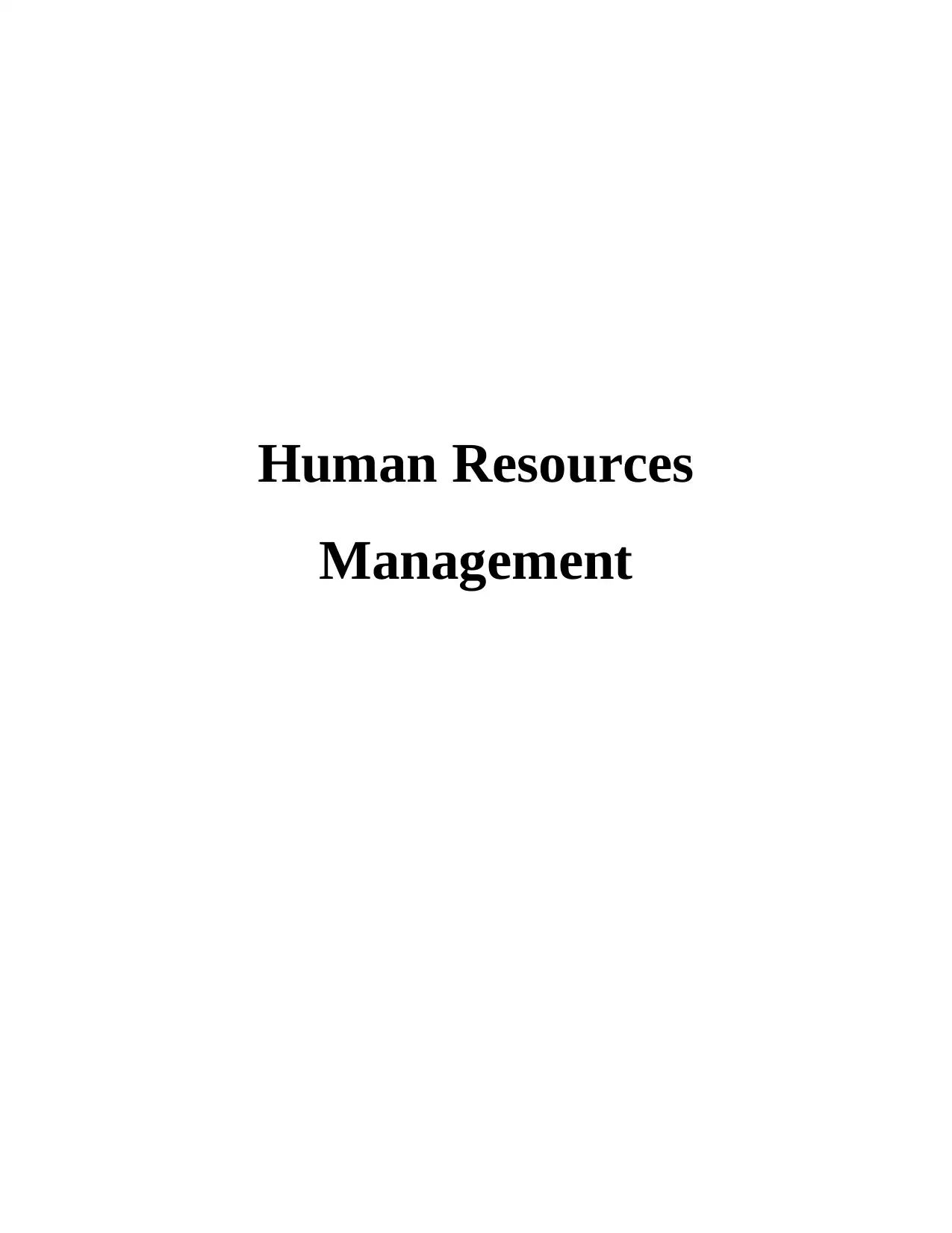
Human Resources
Management
Management
Paraphrase This Document
Need a fresh take? Get an instant paraphrase of this document with our AI Paraphraser
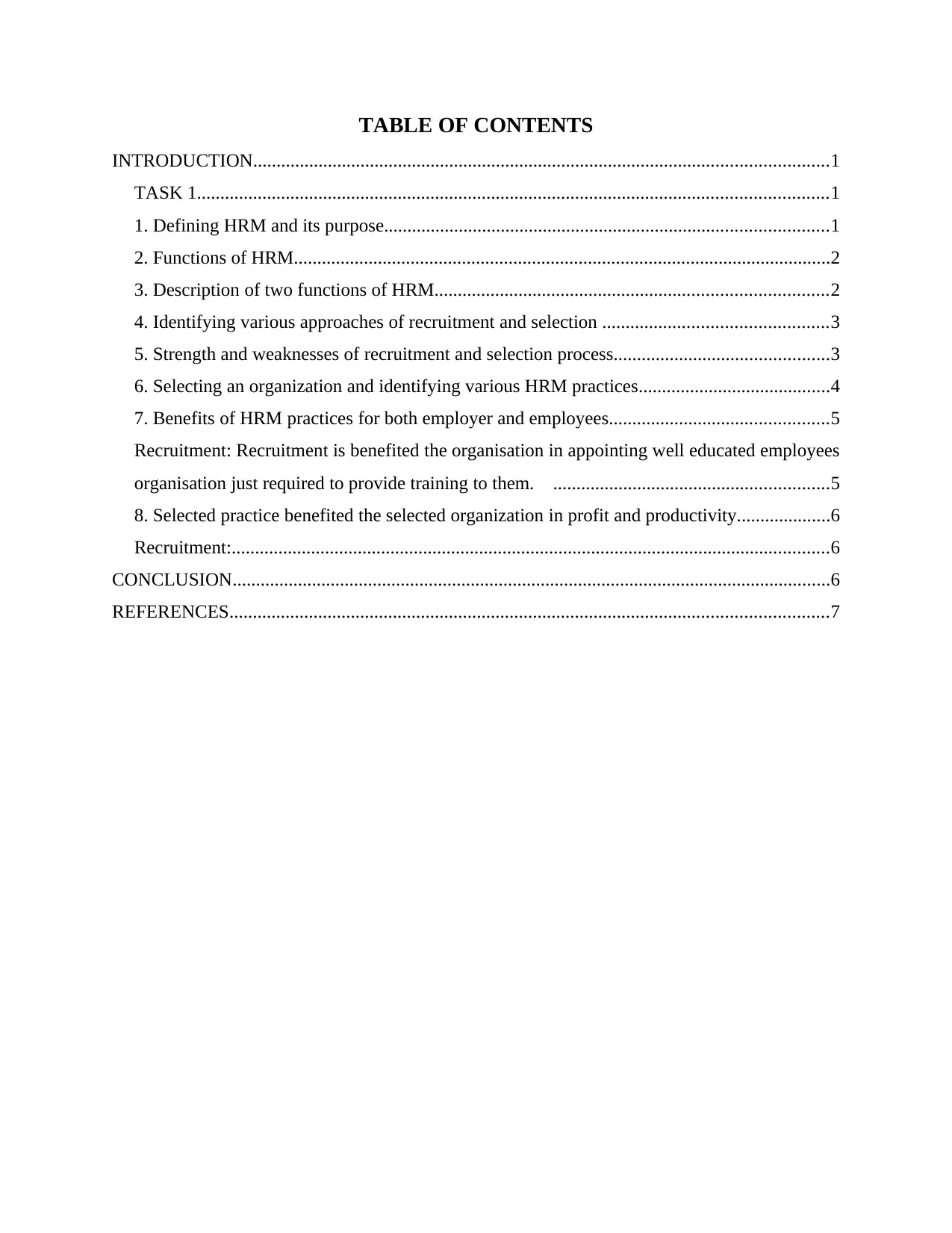
TABLE OF CONTENTS
INTRODUCTION...........................................................................................................................1
TASK 1.......................................................................................................................................1
1. Defining HRM and its purpose...............................................................................................1
2. Functions of HRM...................................................................................................................2
3. Description of two functions of HRM....................................................................................2
4. Identifying various approaches of recruitment and selection ................................................3
5. Strength and weaknesses of recruitment and selection process..............................................3
6. Selecting an organization and identifying various HRM practices.........................................4
7. Benefits of HRM practices for both employer and employees...............................................5
Recruitment: Recruitment is benefited the organisation in appointing well educated employees
organisation just required to provide training to them. ...........................................................5
8. Selected practice benefited the selected organization in profit and productivity....................6
Recruitment:................................................................................................................................6
CONCLUSION................................................................................................................................6
REFERENCES................................................................................................................................7
INTRODUCTION...........................................................................................................................1
TASK 1.......................................................................................................................................1
1. Defining HRM and its purpose...............................................................................................1
2. Functions of HRM...................................................................................................................2
3. Description of two functions of HRM....................................................................................2
4. Identifying various approaches of recruitment and selection ................................................3
5. Strength and weaknesses of recruitment and selection process..............................................3
6. Selecting an organization and identifying various HRM practices.........................................4
7. Benefits of HRM practices for both employer and employees...............................................5
Recruitment: Recruitment is benefited the organisation in appointing well educated employees
organisation just required to provide training to them. ...........................................................5
8. Selected practice benefited the selected organization in profit and productivity....................6
Recruitment:................................................................................................................................6
CONCLUSION................................................................................................................................6
REFERENCES................................................................................................................................7
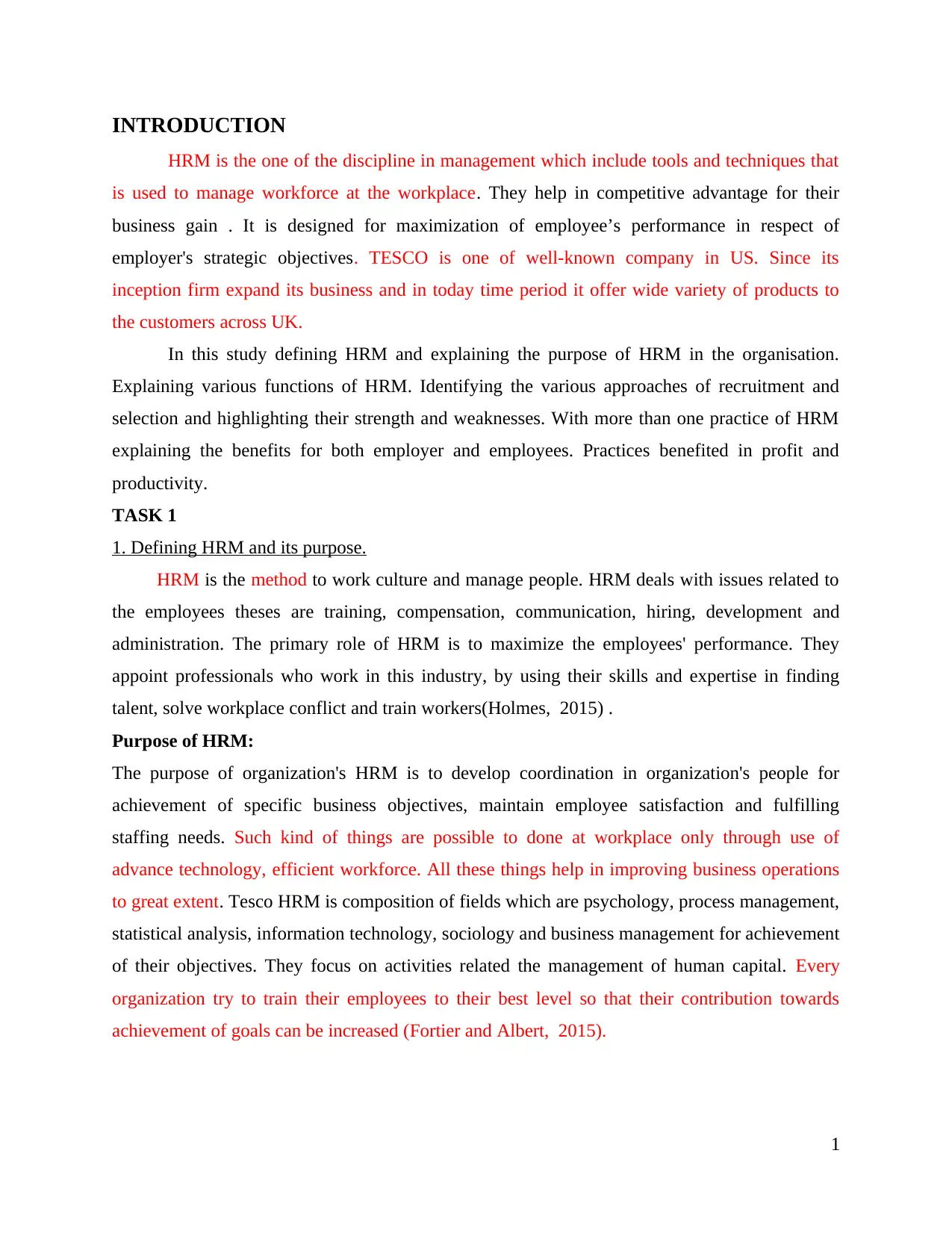
INTRODUCTION
HRM is the one of the discipline in management which include tools and techniques that
is used to manage workforce at the workplace. They help in competitive advantage for their
business gain . It is designed for maximization of employee’s performance in respect of
employer's strategic objectives. TESCO is one of well-known company in US. Since its
inception firm expand its business and in today time period it offer wide variety of products to
the customers across UK.
In this study defining HRM and explaining the purpose of HRM in the organisation.
Explaining various functions of HRM. Identifying the various approaches of recruitment and
selection and highlighting their strength and weaknesses. With more than one practice of HRM
explaining the benefits for both employer and employees. Practices benefited in profit and
productivity.
TASK 1
1. Defining HRM and its purpose.
HRM is the method to work culture and manage people. HRM deals with issues related to
the employees theses are training, compensation, communication, hiring, development and
administration. The primary role of HRM is to maximize the employees' performance. They
appoint professionals who work in this industry, by using their skills and expertise in finding
talent, solve workplace conflict and train workers(Holmes, 2015) .
Purpose of HRM:
The purpose of organization's HRM is to develop coordination in organization's people for
achievement of specific business objectives, maintain employee satisfaction and fulfilling
staffing needs. Such kind of things are possible to done at workplace only through use of
advance technology, efficient workforce. All these things help in improving business operations
to great extent. Tesco HRM is composition of fields which are psychology, process management,
statistical analysis, information technology, sociology and business management for achievement
of their objectives. They focus on activities related the management of human capital. Every
organization try to train their employees to their best level so that their contribution towards
achievement of goals can be increased (Fortier and Albert, 2015).
1
HRM is the one of the discipline in management which include tools and techniques that
is used to manage workforce at the workplace. They help in competitive advantage for their
business gain . It is designed for maximization of employee’s performance in respect of
employer's strategic objectives. TESCO is one of well-known company in US. Since its
inception firm expand its business and in today time period it offer wide variety of products to
the customers across UK.
In this study defining HRM and explaining the purpose of HRM in the organisation.
Explaining various functions of HRM. Identifying the various approaches of recruitment and
selection and highlighting their strength and weaknesses. With more than one practice of HRM
explaining the benefits for both employer and employees. Practices benefited in profit and
productivity.
TASK 1
1. Defining HRM and its purpose.
HRM is the method to work culture and manage people. HRM deals with issues related to
the employees theses are training, compensation, communication, hiring, development and
administration. The primary role of HRM is to maximize the employees' performance. They
appoint professionals who work in this industry, by using their skills and expertise in finding
talent, solve workplace conflict and train workers(Holmes, 2015) .
Purpose of HRM:
The purpose of organization's HRM is to develop coordination in organization's people for
achievement of specific business objectives, maintain employee satisfaction and fulfilling
staffing needs. Such kind of things are possible to done at workplace only through use of
advance technology, efficient workforce. All these things help in improving business operations
to great extent. Tesco HRM is composition of fields which are psychology, process management,
statistical analysis, information technology, sociology and business management for achievement
of their objectives. They focus on activities related the management of human capital. Every
organization try to train their employees to their best level so that their contribution towards
achievement of goals can be increased (Fortier and Albert, 2015).
1
⊘ This is a preview!⊘
Do you want full access?
Subscribe today to unlock all pages.

Trusted by 1+ million students worldwide
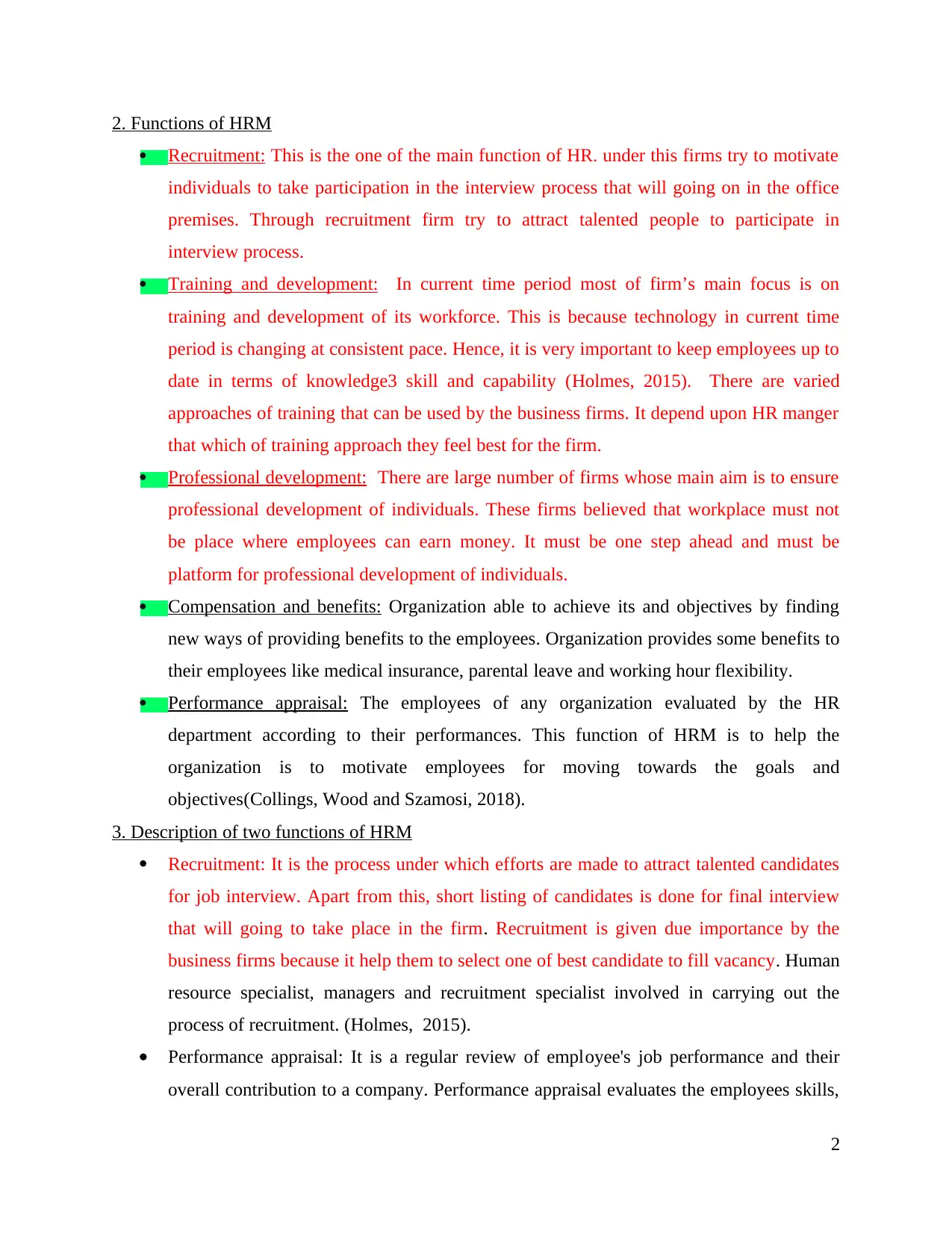
2. Functions of HRM
Recruitment: This is the one of the main function of HR. under this firms try to motivate
individuals to take participation in the interview process that will going on in the office
premises. Through recruitment firm try to attract talented people to participate in
interview process.
Training and development: In current time period most of firm’s main focus is on
training and development of its workforce. This is because technology in current time
period is changing at consistent pace. Hence, it is very important to keep employees up to
date in terms of knowledge3 skill and capability (Holmes, 2015). There are varied
approaches of training that can be used by the business firms. It depend upon HR manger
that which of training approach they feel best for the firm.
Professional development: There are large number of firms whose main aim is to ensure
professional development of individuals. These firms believed that workplace must not
be place where employees can earn money. It must be one step ahead and must be
platform for professional development of individuals.
Compensation and benefits: Organization able to achieve its and objectives by finding
new ways of providing benefits to the employees. Organization provides some benefits to
their employees like medical insurance, parental leave and working hour flexibility.
Performance appraisal: The employees of any organization evaluated by the HR
department according to their performances. This function of HRM is to help the
organization is to motivate employees for moving towards the goals and
objectives(Collings, Wood and Szamosi, 2018).
3. Description of two functions of HRM
Recruitment: It is the process under which efforts are made to attract talented candidates
for job interview. Apart from this, short listing of candidates is done for final interview
that will going to take place in the firm. Recruitment is given due importance by the
business firms because it help them to select one of best candidate to fill vacancy. Human
resource specialist, managers and recruitment specialist involved in carrying out the
process of recruitment. (Holmes, 2015).
Performance appraisal: It is a regular review of employee's job performance and their
overall contribution to a company. Performance appraisal evaluates the employees skills,
2
Recruitment: This is the one of the main function of HR. under this firms try to motivate
individuals to take participation in the interview process that will going on in the office
premises. Through recruitment firm try to attract talented people to participate in
interview process.
Training and development: In current time period most of firm’s main focus is on
training and development of its workforce. This is because technology in current time
period is changing at consistent pace. Hence, it is very important to keep employees up to
date in terms of knowledge3 skill and capability (Holmes, 2015). There are varied
approaches of training that can be used by the business firms. It depend upon HR manger
that which of training approach they feel best for the firm.
Professional development: There are large number of firms whose main aim is to ensure
professional development of individuals. These firms believed that workplace must not
be place where employees can earn money. It must be one step ahead and must be
platform for professional development of individuals.
Compensation and benefits: Organization able to achieve its and objectives by finding
new ways of providing benefits to the employees. Organization provides some benefits to
their employees like medical insurance, parental leave and working hour flexibility.
Performance appraisal: The employees of any organization evaluated by the HR
department according to their performances. This function of HRM is to help the
organization is to motivate employees for moving towards the goals and
objectives(Collings, Wood and Szamosi, 2018).
3. Description of two functions of HRM
Recruitment: It is the process under which efforts are made to attract talented candidates
for job interview. Apart from this, short listing of candidates is done for final interview
that will going to take place in the firm. Recruitment is given due importance by the
business firms because it help them to select one of best candidate to fill vacancy. Human
resource specialist, managers and recruitment specialist involved in carrying out the
process of recruitment. (Holmes, 2015).
Performance appraisal: It is a regular review of employee's job performance and their
overall contribution to a company. Performance appraisal evaluates the employees skills,
2
Paraphrase This Document
Need a fresh take? Get an instant paraphrase of this document with our AI Paraphraser
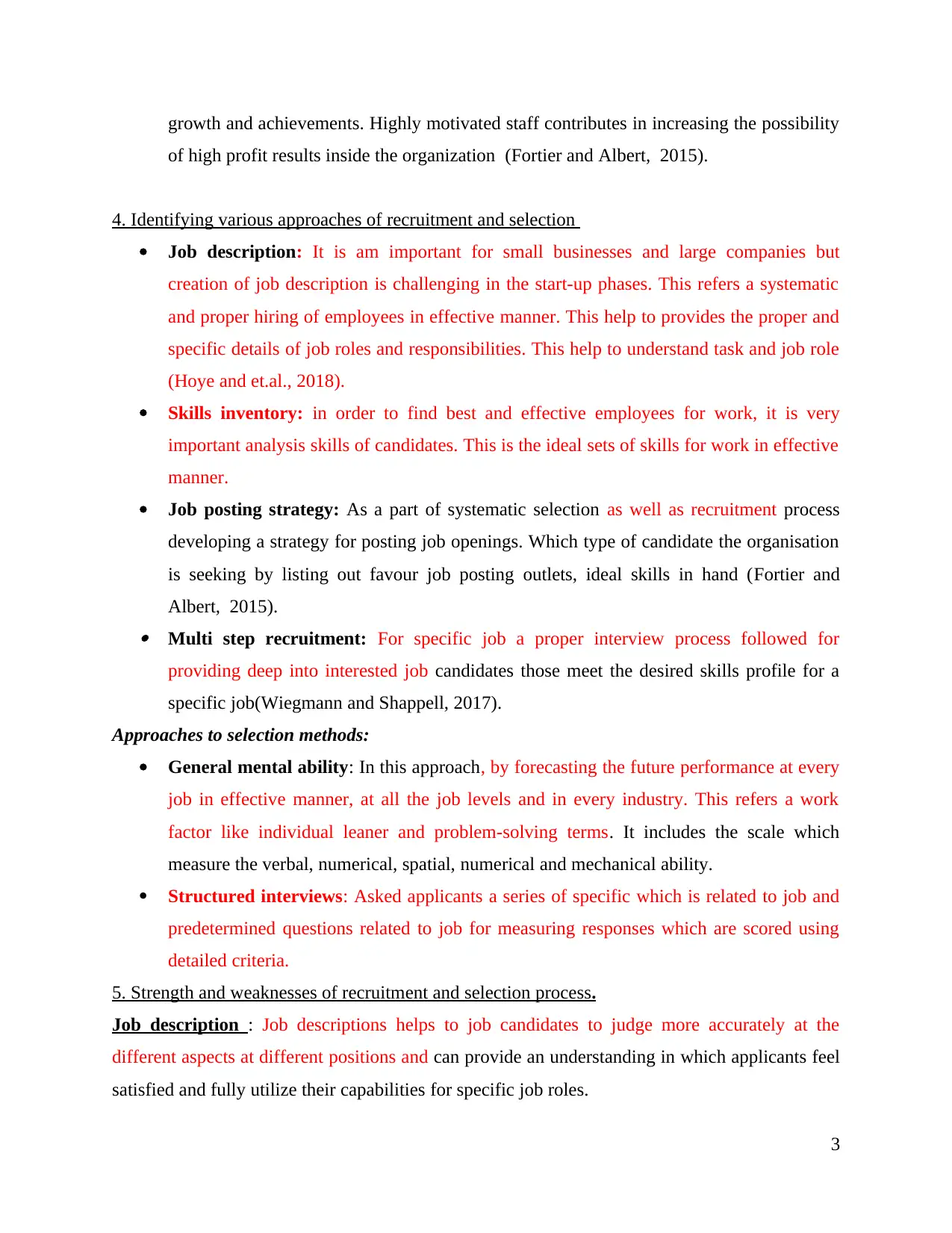
growth and achievements. Highly motivated staff contributes in increasing the possibility
of high profit results inside the organization (Fortier and Albert, 2015).
4. Identifying various approaches of recruitment and selection
Job description: It is am important for small businesses and large companies but
creation of job description is challenging in the start-up phases. This refers a systematic
and proper hiring of employees in effective manner. This help to provides the proper and
specific details of job roles and responsibilities. This help to understand task and job role
(Hoye and et.al., 2018).
Skills inventory: in order to find best and effective employees for work, it is very
important analysis skills of candidates. This is the ideal sets of skills for work in effective
manner.
Job posting strategy: As a part of systematic selection as well as recruitment process
developing a strategy for posting job openings. Which type of candidate the organisation
is seeking by listing out favour job posting outlets, ideal skills in hand (Fortier and
Albert, 2015). Multi step recruitment: For specific job a proper interview process followed for
providing deep into interested job candidates those meet the desired skills profile for a
specific job(Wiegmann and Shappell, 2017).
Approaches to selection methods:
General mental ability: In this approach, by forecasting the future performance at every
job in effective manner, at all the job levels and in every industry. This refers a work
factor like individual leaner and problem-solving terms. It includes the scale which
measure the verbal, numerical, spatial, numerical and mechanical ability.
Structured interviews: Asked applicants a series of specific which is related to job and
predetermined questions related to job for measuring responses which are scored using
detailed criteria.
5. Strength and weaknesses of recruitment and selection process.
Job description : Job descriptions helps to job candidates to judge more accurately at the
different aspects at different positions and can provide an understanding in which applicants feel
satisfied and fully utilize their capabilities for specific job roles.
3
of high profit results inside the organization (Fortier and Albert, 2015).
4. Identifying various approaches of recruitment and selection
Job description: It is am important for small businesses and large companies but
creation of job description is challenging in the start-up phases. This refers a systematic
and proper hiring of employees in effective manner. This help to provides the proper and
specific details of job roles and responsibilities. This help to understand task and job role
(Hoye and et.al., 2018).
Skills inventory: in order to find best and effective employees for work, it is very
important analysis skills of candidates. This is the ideal sets of skills for work in effective
manner.
Job posting strategy: As a part of systematic selection as well as recruitment process
developing a strategy for posting job openings. Which type of candidate the organisation
is seeking by listing out favour job posting outlets, ideal skills in hand (Fortier and
Albert, 2015). Multi step recruitment: For specific job a proper interview process followed for
providing deep into interested job candidates those meet the desired skills profile for a
specific job(Wiegmann and Shappell, 2017).
Approaches to selection methods:
General mental ability: In this approach, by forecasting the future performance at every
job in effective manner, at all the job levels and in every industry. This refers a work
factor like individual leaner and problem-solving terms. It includes the scale which
measure the verbal, numerical, spatial, numerical and mechanical ability.
Structured interviews: Asked applicants a series of specific which is related to job and
predetermined questions related to job for measuring responses which are scored using
detailed criteria.
5. Strength and weaknesses of recruitment and selection process.
Job description : Job descriptions helps to job candidates to judge more accurately at the
different aspects at different positions and can provide an understanding in which applicants feel
satisfied and fully utilize their capabilities for specific job roles.
3
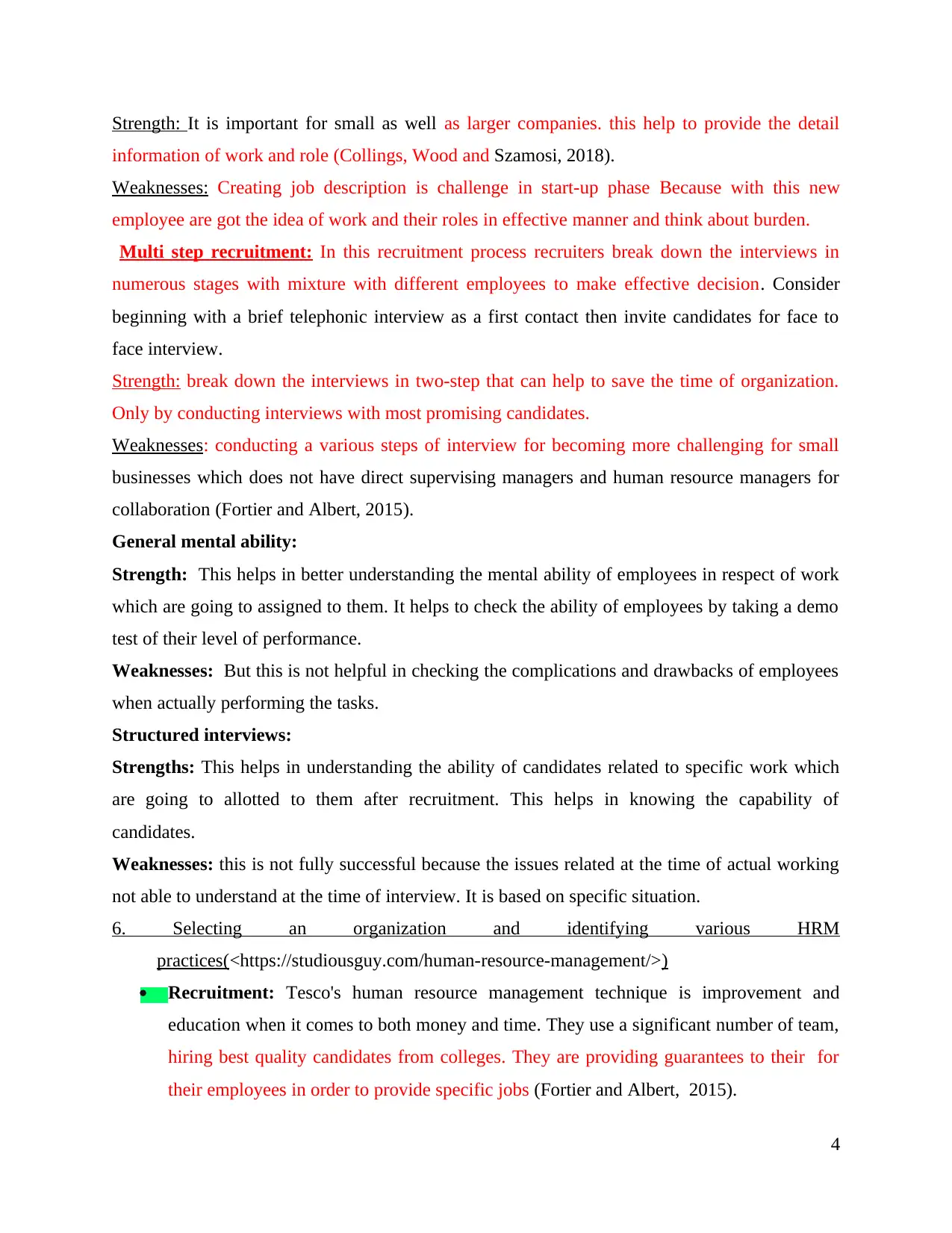
Strength: It is important for small as well as larger companies. this help to provide the detail
information of work and role (Collings, Wood and Szamosi, 2018).
Weaknesses: Creating job description is challenge in start-up phase Because with this new
employee are got the idea of work and their roles in effective manner and think about burden.
Multi step recruitment: In this recruitment process recruiters break down the interviews in
numerous stages with mixture with different employees to make effective decision. Consider
beginning with a brief telephonic interview as a first contact then invite candidates for face to
face interview.
Strength: break down the interviews in two-step that can help to save the time of organization.
Only by conducting interviews with most promising candidates.
Weaknesses: conducting a various steps of interview for becoming more challenging for small
businesses which does not have direct supervising managers and human resource managers for
collaboration (Fortier and Albert, 2015).
General mental ability:
Strength: This helps in better understanding the mental ability of employees in respect of work
which are going to assigned to them. It helps to check the ability of employees by taking a demo
test of their level of performance.
Weaknesses: But this is not helpful in checking the complications and drawbacks of employees
when actually performing the tasks.
Structured interviews:
Strengths: This helps in understanding the ability of candidates related to specific work which
are going to allotted to them after recruitment. This helps in knowing the capability of
candidates.
Weaknesses: this is not fully successful because the issues related at the time of actual working
not able to understand at the time of interview. It is based on specific situation.
6. Selecting an organization and identifying various HRM
practices(<https://studiousguy.com/human-resource-management/>)
Recruitment: Tesco's human resource management technique is improvement and
education when it comes to both money and time. They use a significant number of team,
hiring best quality candidates from colleges. They are providing guarantees to their for
their employees in order to provide specific jobs (Fortier and Albert, 2015).
4
information of work and role (Collings, Wood and Szamosi, 2018).
Weaknesses: Creating job description is challenge in start-up phase Because with this new
employee are got the idea of work and their roles in effective manner and think about burden.
Multi step recruitment: In this recruitment process recruiters break down the interviews in
numerous stages with mixture with different employees to make effective decision. Consider
beginning with a brief telephonic interview as a first contact then invite candidates for face to
face interview.
Strength: break down the interviews in two-step that can help to save the time of organization.
Only by conducting interviews with most promising candidates.
Weaknesses: conducting a various steps of interview for becoming more challenging for small
businesses which does not have direct supervising managers and human resource managers for
collaboration (Fortier and Albert, 2015).
General mental ability:
Strength: This helps in better understanding the mental ability of employees in respect of work
which are going to assigned to them. It helps to check the ability of employees by taking a demo
test of their level of performance.
Weaknesses: But this is not helpful in checking the complications and drawbacks of employees
when actually performing the tasks.
Structured interviews:
Strengths: This helps in understanding the ability of candidates related to specific work which
are going to allotted to them after recruitment. This helps in knowing the capability of
candidates.
Weaknesses: this is not fully successful because the issues related at the time of actual working
not able to understand at the time of interview. It is based on specific situation.
6. Selecting an organization and identifying various HRM
practices(<https://studiousguy.com/human-resource-management/>)
Recruitment: Tesco's human resource management technique is improvement and
education when it comes to both money and time. They use a significant number of team,
hiring best quality candidates from colleges. They are providing guarantees to their for
their employees in order to provide specific jobs (Fortier and Albert, 2015).
4
⊘ This is a preview!⊘
Do you want full access?
Subscribe today to unlock all pages.

Trusted by 1+ million students worldwide
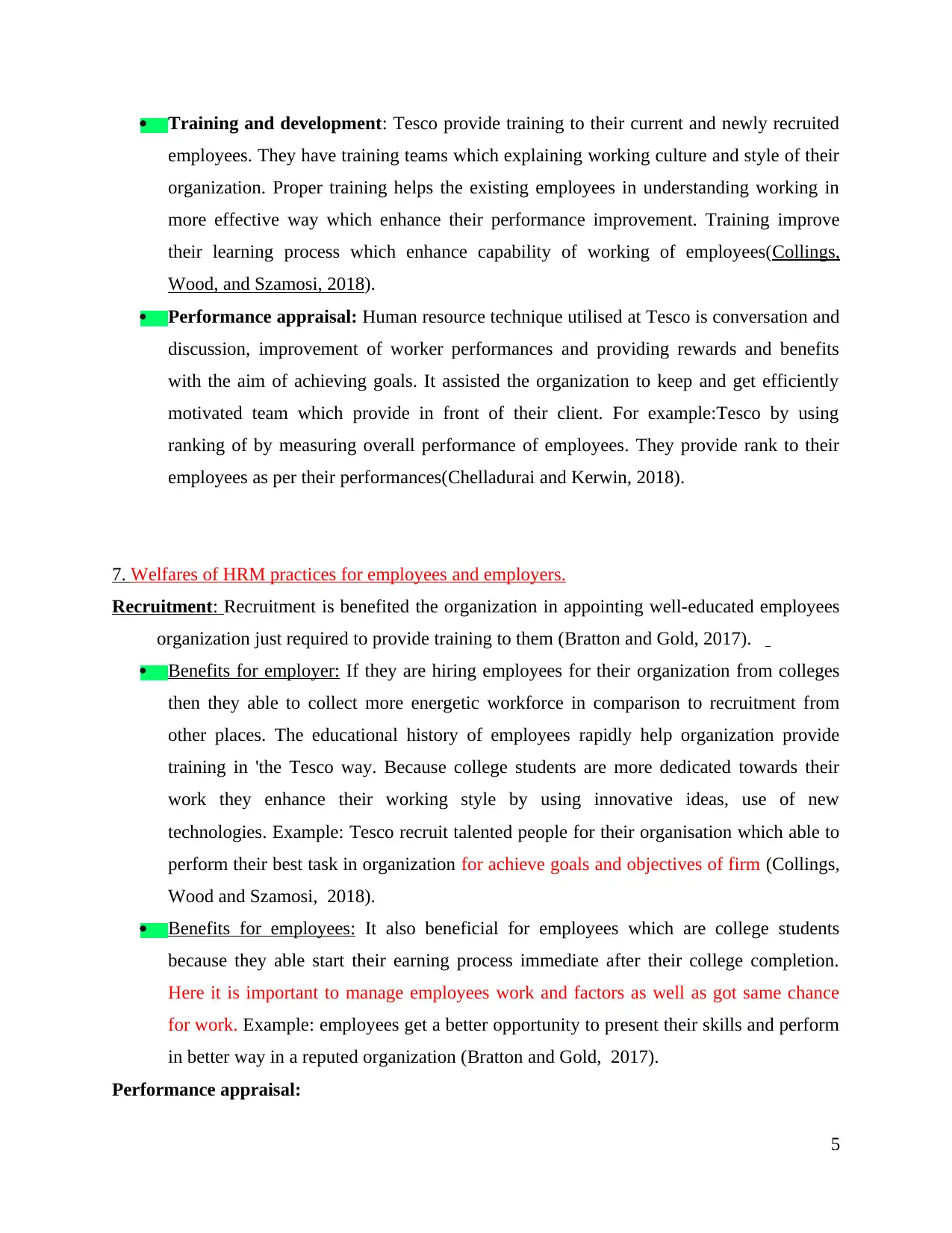
Training and development: Tesco provide training to their current and newly recruited
employees. They have training teams which explaining working culture and style of their
organization. Proper training helps the existing employees in understanding working in
more effective way which enhance their performance improvement. Training improve
their learning process which enhance capability of working of employees(Collings,
Wood, and Szamosi, 2018).
Performance appraisal: Human resource technique utilised at Tesco is conversation and
discussion, improvement of worker performances and providing rewards and benefits
with the aim of achieving goals. It assisted the organization to keep and get efficiently
motivated team which provide in front of their client. For example:Tesco by using
ranking of by measuring overall performance of employees. They provide rank to their
employees as per their performances(Chelladurai and Kerwin, 2018).
7. Welfares of HRM practices for employees and employers.
Recruitment: Recruitment is benefited the organization in appointing well-educated employees
organization just required to provide training to them (Bratton and Gold, 2017).
Benefits for employer: If they are hiring employees for their organization from colleges
then they able to collect more energetic workforce in comparison to recruitment from
other places. The educational history of employees rapidly help organization provide
training in 'the Tesco way. Because college students are more dedicated towards their
work they enhance their working style by using innovative ideas, use of new
technologies. Example: Tesco recruit talented people for their organisation which able to
perform their best task in organization for achieve goals and objectives of firm (Collings,
Wood and Szamosi, 2018).
Benefits for employees: It also beneficial for employees which are college students
because they able start their earning process immediate after their college completion.
Here it is important to manage employees work and factors as well as got same chance
for work. Example: employees get a better opportunity to present their skills and perform
in better way in a reputed organization (Bratton and Gold, 2017).
Performance appraisal:
5
employees. They have training teams which explaining working culture and style of their
organization. Proper training helps the existing employees in understanding working in
more effective way which enhance their performance improvement. Training improve
their learning process which enhance capability of working of employees(Collings,
Wood, and Szamosi, 2018).
Performance appraisal: Human resource technique utilised at Tesco is conversation and
discussion, improvement of worker performances and providing rewards and benefits
with the aim of achieving goals. It assisted the organization to keep and get efficiently
motivated team which provide in front of their client. For example:Tesco by using
ranking of by measuring overall performance of employees. They provide rank to their
employees as per their performances(Chelladurai and Kerwin, 2018).
7. Welfares of HRM practices for employees and employers.
Recruitment: Recruitment is benefited the organization in appointing well-educated employees
organization just required to provide training to them (Bratton and Gold, 2017).
Benefits for employer: If they are hiring employees for their organization from colleges
then they able to collect more energetic workforce in comparison to recruitment from
other places. The educational history of employees rapidly help organization provide
training in 'the Tesco way. Because college students are more dedicated towards their
work they enhance their working style by using innovative ideas, use of new
technologies. Example: Tesco recruit talented people for their organisation which able to
perform their best task in organization for achieve goals and objectives of firm (Collings,
Wood and Szamosi, 2018).
Benefits for employees: It also beneficial for employees which are college students
because they able start their earning process immediate after their college completion.
Here it is important to manage employees work and factors as well as got same chance
for work. Example: employees get a better opportunity to present their skills and perform
in better way in a reputed organization (Bratton and Gold, 2017).
Performance appraisal:
5
Paraphrase This Document
Need a fresh take? Get an instant paraphrase of this document with our AI Paraphraser
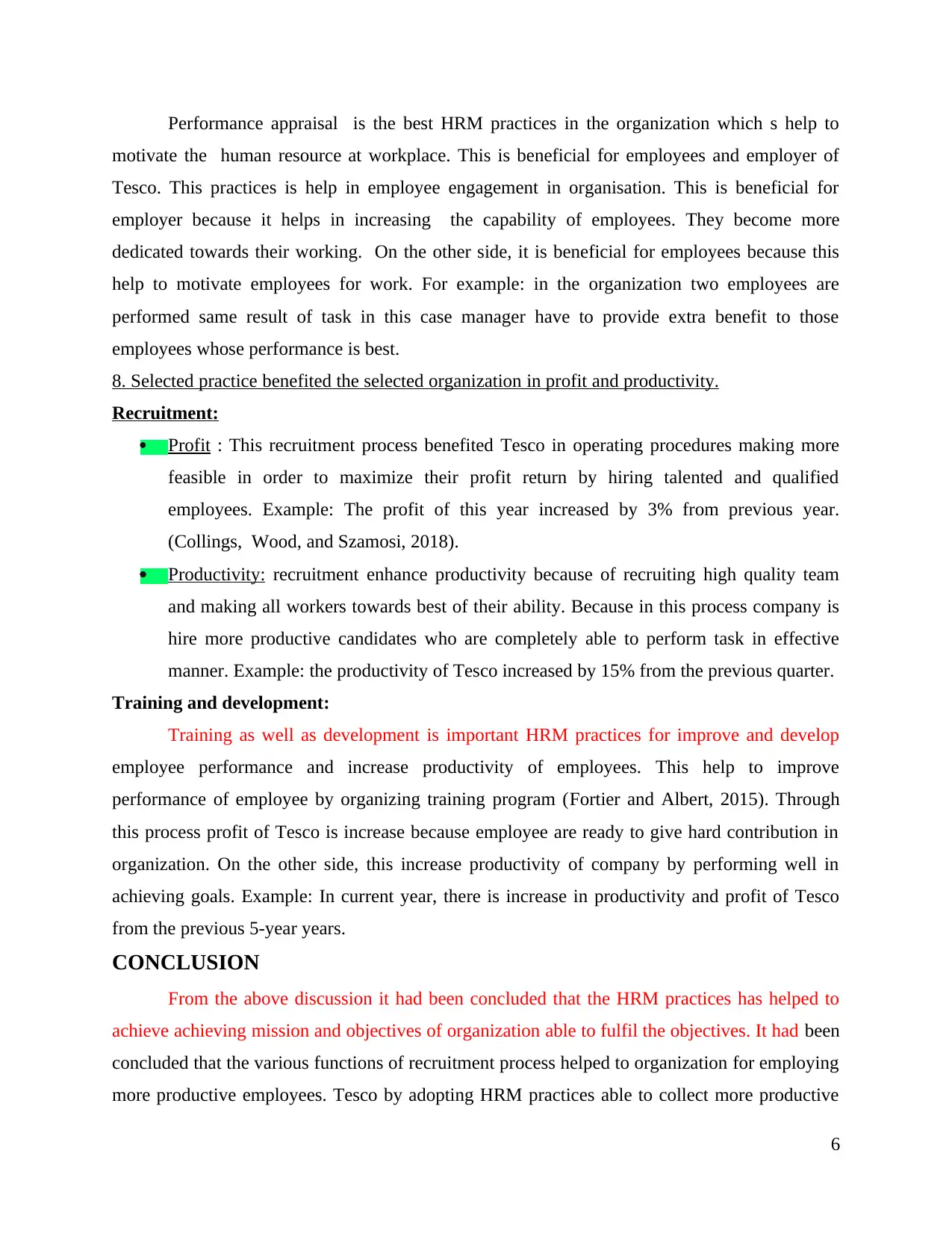
Performance appraisal is the best HRM practices in the organization which s help to
motivate the human resource at workplace. This is beneficial for employees and employer of
Tesco. This practices is help in employee engagement in organisation. This is beneficial for
employer because it helps in increasing the capability of employees. They become more
dedicated towards their working. On the other side, it is beneficial for employees because this
help to motivate employees for work. For example: in the organization two employees are
performed same result of task in this case manager have to provide extra benefit to those
employees whose performance is best.
8. Selected practice benefited the selected organization in profit and productivity.
Recruitment:
Profit : This recruitment process benefited Tesco in operating procedures making more
feasible in order to maximize their profit return by hiring talented and qualified
employees. Example: The profit of this year increased by 3% from previous year.
(Collings, Wood, and Szamosi, 2018).
Productivity: recruitment enhance productivity because of recruiting high quality team
and making all workers towards best of their ability. Because in this process company is
hire more productive candidates who are completely able to perform task in effective
manner. Example: the productivity of Tesco increased by 15% from the previous quarter.
Training and development:
Training as well as development is important HRM practices for improve and develop
employee performance and increase productivity of employees. This help to improve
performance of employee by organizing training program (Fortier and Albert, 2015). Through
this process profit of Tesco is increase because employee are ready to give hard contribution in
organization. On the other side, this increase productivity of company by performing well in
achieving goals. Example: In current year, there is increase in productivity and profit of Tesco
from the previous 5-year years.
CONCLUSION
From the above discussion it had been concluded that the HRM practices has helped to
achieve achieving mission and objectives of organization able to fulfil the objectives. It had been
concluded that the various functions of recruitment process helped to organization for employing
more productive employees. Tesco by adopting HRM practices able to collect more productive
6
motivate the human resource at workplace. This is beneficial for employees and employer of
Tesco. This practices is help in employee engagement in organisation. This is beneficial for
employer because it helps in increasing the capability of employees. They become more
dedicated towards their working. On the other side, it is beneficial for employees because this
help to motivate employees for work. For example: in the organization two employees are
performed same result of task in this case manager have to provide extra benefit to those
employees whose performance is best.
8. Selected practice benefited the selected organization in profit and productivity.
Recruitment:
Profit : This recruitment process benefited Tesco in operating procedures making more
feasible in order to maximize their profit return by hiring talented and qualified
employees. Example: The profit of this year increased by 3% from previous year.
(Collings, Wood, and Szamosi, 2018).
Productivity: recruitment enhance productivity because of recruiting high quality team
and making all workers towards best of their ability. Because in this process company is
hire more productive candidates who are completely able to perform task in effective
manner. Example: the productivity of Tesco increased by 15% from the previous quarter.
Training and development:
Training as well as development is important HRM practices for improve and develop
employee performance and increase productivity of employees. This help to improve
performance of employee by organizing training program (Fortier and Albert, 2015). Through
this process profit of Tesco is increase because employee are ready to give hard contribution in
organization. On the other side, this increase productivity of company by performing well in
achieving goals. Example: In current year, there is increase in productivity and profit of Tesco
from the previous 5-year years.
CONCLUSION
From the above discussion it had been concluded that the HRM practices has helped to
achieve achieving mission and objectives of organization able to fulfil the objectives. It had been
concluded that the various functions of recruitment process helped to organization for employing
more productive employees. Tesco by adopting HRM practices able to collect more productive
6
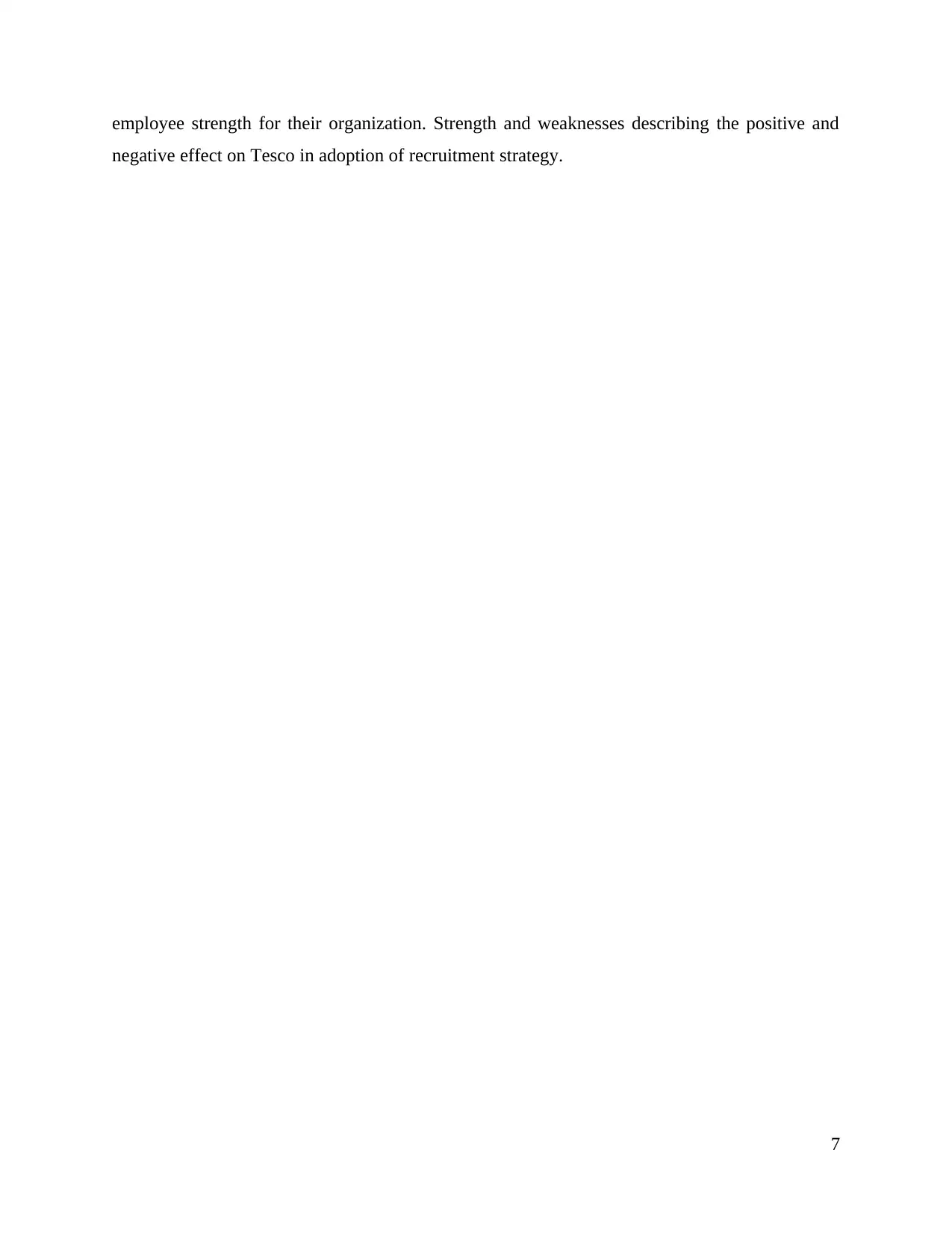
employee strength for their organization. Strength and weaknesses describing the positive and
negative effect on Tesco in adoption of recruitment strategy.
7
negative effect on Tesco in adoption of recruitment strategy.
7
⊘ This is a preview!⊘
Do you want full access?
Subscribe today to unlock all pages.

Trusted by 1+ million students worldwide
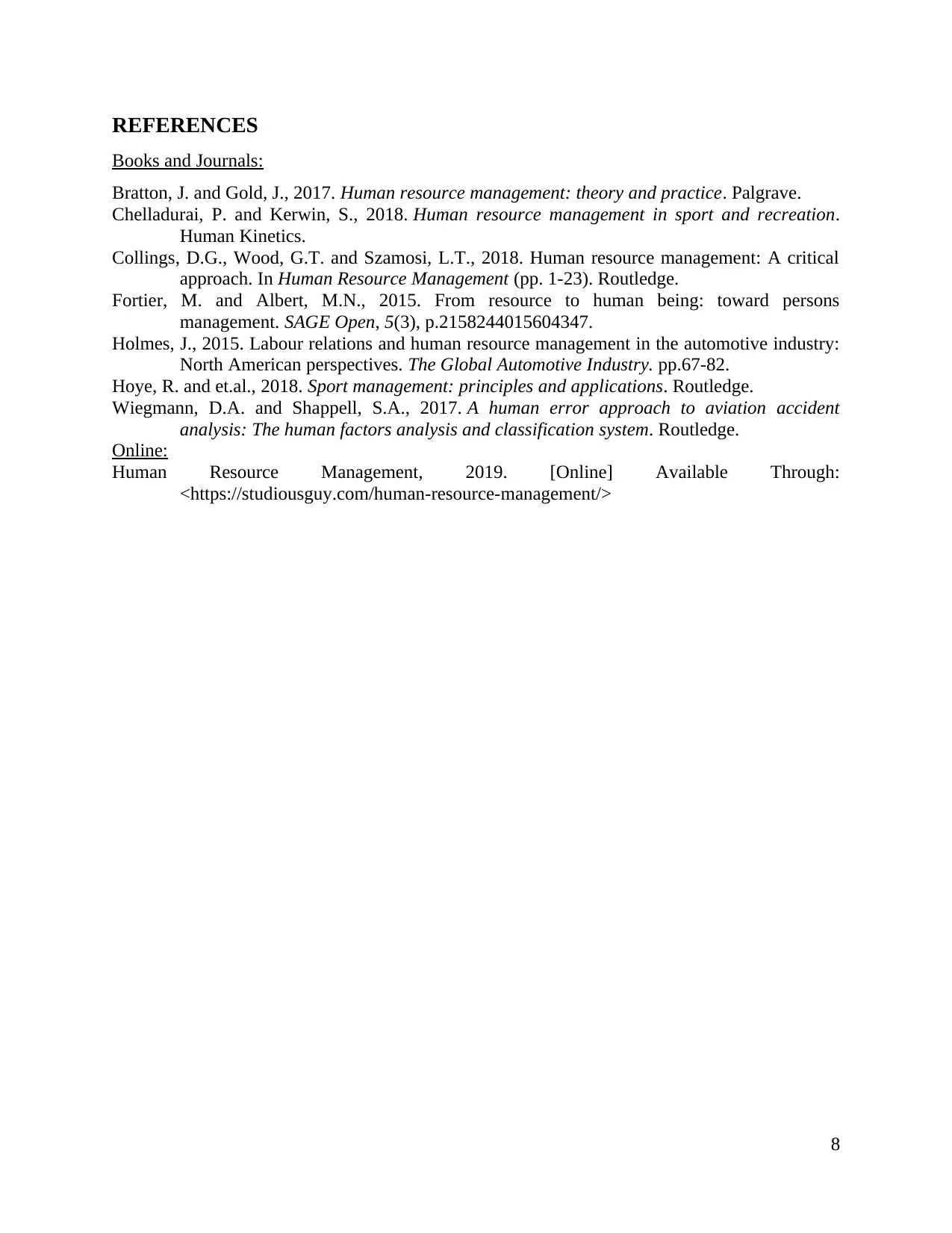
REFERENCES
Books and Journals:
Bratton, J. and Gold, J., 2017. Human resource management: theory and practice. Palgrave.
Chelladurai, P. and Kerwin, S., 2018. Human resource management in sport and recreation.
Human Kinetics.
Collings, D.G., Wood, G.T. and Szamosi, L.T., 2018. Human resource management: A critical
approach. In Human Resource Management (pp. 1-23). Routledge.
Fortier, M. and Albert, M.N., 2015. From resource to human being: toward persons
management. SAGE Open, 5(3), p.2158244015604347.
Holmes, J., 2015. Labour relations and human resource management in the automotive industry:
North American perspectives. The Global Automotive Industry. pp.67-82.
Hoye, R. and et.al., 2018. Sport management: principles and applications. Routledge.
Wiegmann, D.A. and Shappell, S.A., 2017. A human error approach to aviation accident
analysis: The human factors analysis and classification system. Routledge.
Online:
Human Resource Management, 2019. [Online] Available Through:
<https://studiousguy.com/human-resource-management/>
8
Books and Journals:
Bratton, J. and Gold, J., 2017. Human resource management: theory and practice. Palgrave.
Chelladurai, P. and Kerwin, S., 2018. Human resource management in sport and recreation.
Human Kinetics.
Collings, D.G., Wood, G.T. and Szamosi, L.T., 2018. Human resource management: A critical
approach. In Human Resource Management (pp. 1-23). Routledge.
Fortier, M. and Albert, M.N., 2015. From resource to human being: toward persons
management. SAGE Open, 5(3), p.2158244015604347.
Holmes, J., 2015. Labour relations and human resource management in the automotive industry:
North American perspectives. The Global Automotive Industry. pp.67-82.
Hoye, R. and et.al., 2018. Sport management: principles and applications. Routledge.
Wiegmann, D.A. and Shappell, S.A., 2017. A human error approach to aviation accident
analysis: The human factors analysis and classification system. Routledge.
Online:
Human Resource Management, 2019. [Online] Available Through:
<https://studiousguy.com/human-resource-management/>
8
1 out of 10
Related Documents
Your All-in-One AI-Powered Toolkit for Academic Success.
+13062052269
info@desklib.com
Available 24*7 on WhatsApp / Email
![[object Object]](/_next/static/media/star-bottom.7253800d.svg)
Unlock your academic potential
Copyright © 2020–2025 A2Z Services. All Rights Reserved. Developed and managed by ZUCOL.





